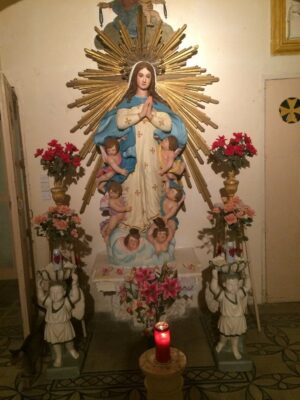I did my fair share of tracing as a young boy — and my favourite tracing paper was the very same baking paper my mum used in the kitchen. My earliest tracings were of airplanes and dramatic wartime scenes, copied from a well-worn edition of the London Illustrated News I found in my grandpa’s library. Remarkably, I still own those tracings, and I truly believe they were the very first sparks that ignited my lifelong passion for art.
Although I’m essentially self-taught, my formal artistic journey began in the early 1970s during my time as a student at the Lyceum. There, I was fortunate to receive art tutoring from none other than Antoine Camilleri (1922–2005), one of Malta’s leading artists and a name cherished by many art lovers. Looking back, I feel incredibly lucky to have begun under the guidance of such a respected figure.
Our early lessons focused on designing and painting patterns inspired by traditional Maltese tilework. Using poster colours, we had to create intricate motifs that could be replicated seamlessly — each design a tessellation of a single basic cell. At first, the challenge intrigued me, but it didn’t take long before repetition wore thin. I wanted something more engaging, more human.
I remember asking my tutor if I could try something different. Despite the rest of the class continuing with their tile designs, he welcomed my request. He handed me a small wooden mannequin — the kind you can pose into different stances. It became my new challenge. I began drawing it in pencil, paying close attention not just to proportion and pose but also to the complexities of shadow and light. That shift opened up a whole new dimension in my approach to drawing, and Antoine’s flexibility left a lasting impression on me.
Later in my Lyceum years, a very unexpected opportunity came my way. My cousin, Michelina Mifsud — a cloistered nun at St Catherine’s Monastery in Valletta — asked me to carry out a minor restoration on a beloved statue of the Madonna known as il-Madonna tal-Monasteru, housed in the crypt of the monastery. According to tradition, this Madonna is considered miraculous, with her apparition dating back to Saturday, 6th November 1710, when she appeared to a group of praying nuns.
I wasn’t a trained restorer, nor was I aware at the time that such work should ideally be handled by professionals. But since the task was simply to touch up areas where paint had peeled, I accepted — and in doing so, I bought my first set of oil paints and brushes.
Access to the crypt required a special procedure. The monastery, being a cloistered environment, strictly barred outsiders — especially men — from entering. But I was granted permission, and I still remember the experience vividly. The mother superior led me through the quiet corridors, ringing a bell loud enough for all of Valletta to hear — a signal for the nuns to return to their rooms and avoid any contact. It felt surreal, like stepping into a different world.
That formality didn’t last long, though. Over time, I was welcomed into their quiet community, and those six Saturdays — my only free time from studies — became something I looked forward to deeply. The Madonna had a powerful presence, and being so close to her for those sessions left a permanent mark on me.
Nearly 50 years later, in 2019, I returned to the crypt. This time, Michelina — now Sister Michaelina — had become the Mother Superior herself. Restoration works were ongoing, now backed by government funding, and the statue had undergone professional conservation. Revisiting that space, surrounded by memory and devotion, was emotional. It felt like reconnecting with an old friend — and with a formative chapter in my life that helped shape the artist I am today.

